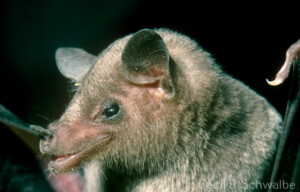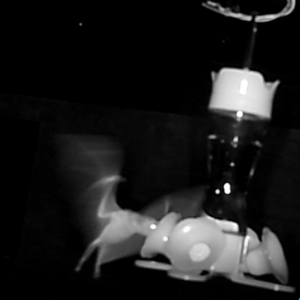For this week’s Friday creature feature, let’s take a closer look at the lesser long-nosed bat (Leptonycteris yerbabuenae), one of the Sonoran Desert’s most important pollinator species for plants like agave and various kinds of cacti, including saguaro and organ pipe.
Description:

Lesser Long-nosed Bat (Leptonycteris yerbabuenae, Phyllostomidae) is found across the American Southwest and Northern Mexico.© Cecil R. Schwalbe
The lesser long-nosed bat, Audubon Arizona reports, weighs as much as four quarters and measures about three inches (8 cm) long. Its tongue is the same length, giving it ample opportunity to drink nectar from long, deep, night-blooming flowers. It is typically tan, brown, or cinnamon in color with grey wings. When in flight, the wings measure 10 inches.
Pregnant lesser long-nosed bats give birth once a year, usually in April, to one pup. The pups mature quickly and can fly as soon as four weeks after being born. One cool fact about female bats is that they congregate in caves (called maternity roosts) during birthing season. While they still feed and nurture their young solo, these groups can host up to one hundred thousand (100,000) pregnant females and mothers at a time.
According to the National Park Service, there are only three known maternity roosts in the U.S.
Habitat:
The lesser long-nosed bat prefers to live in arid regions. Its migratory range includes northern Mexico as well as parts of Arizona and New Mexico. The species typically winters in Mexico and returns to the U.S. during the hotter months of the year.
Behavior:
The lesser long-nosed bat, like all bats, is nocturnal. It sleeps in caves or abandoned mines during the day and often returns to the same sanctuary to roost. At night, the bat surveys a range of cacti and agave for blooming desert flowers. In exchange for the flower’s nectar, a fine layer of pollen from each flower sticks to the bat’s tongue and hair and helps cross-pollinate other plants.
Diet:
As a pollinator, the lesser long-nosed bat relies on the nectar from agave and cacti blooms (and sometimes neighborhood hummingbird feeders) for sustenance. Depending on food availability, they will also feed on insects and cacti fruit. One fun fact about this bat’s special diet—the lesser long-nosed bat also helps propagate cacti species across long distances. Seeds from consumed fruit pulp are spread through guano (bat feces).
Status:
The lesser long-nosed bat was listed as an endangered species in North America in 1988. Habitat destruction and scarce food sources (mostly due to the overharvesting of agave for tequila) are two of the main reasons this pollinator species had declined in population last century. Fortunately, the species was delisted in 2018 after documented species recovery because of enhanced roost site management and restoration of food sources.
Identification Tips:
While this species is pretty rarely spotted in the wild, you may find one drinking at your hummingbird feeder after their long migration north from Mexico. (Have you set up your backyard camera yet? If not, here’s how.)
Here are some traits to look for when identifying the lesser long-nosed bat:
- A triangular-shaped noseleaf that hooks off the nose
- Hair colored shades of yellow-brown, rust-brown, or cinnamon-grey
- A long (3 in) tongue
- Very short tail and small ears
- Little membranes between hind legs and tail
- A ten-inch wingspan



